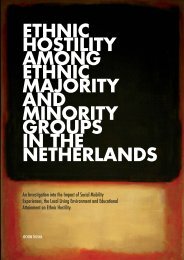Association of criminal convictions between family members: Effects ...
Association of criminal convictions between family members: Effects ...
Association of criminal convictions between family members: Effects ...
You also want an ePaper? Increase the reach of your titles
YUMPU automatically turns print PDFs into web optimized ePapers that Google loves.
106van de Rakt et al.DiscussionResearch shows that <strong>criminal</strong> behaviour tends to be strongly clustered withinfamilies (Farrington et al., 1996), in particular among siblings (Haynie andMcHugh, 2003). The aim <strong>of</strong> the present study was to investigate the strength <strong>of</strong>the correlation <strong>between</strong> <strong>convictions</strong> <strong>of</strong> <strong>family</strong> <strong>members</strong> and an individual’s ownlikelihood <strong>of</strong> conviction. This study contributes to the limited but growing body<strong>of</strong> research on the inter-generational transmission <strong>of</strong> <strong>criminal</strong> behaviour (fromparent to child) as well as the intra-generational transmission <strong>of</strong> <strong>criminal</strong> behaviour(from sibling to sibling). Data from the CCLS – a unique, large-scale datasetwith 4988 men and their 8018 children – allowed a detailed description <strong>of</strong> thenature <strong>of</strong> these relationships.The results show a strong association <strong>of</strong> <strong>convictions</strong> <strong>between</strong> siblings. Thecorrelation <strong>between</strong> the numbers <strong>of</strong> <strong>convictions</strong> <strong>of</strong> siblings was about 0.30, arelationship that held for male as well as female siblings. There was a less strongcorrelation <strong>between</strong> the <strong>criminal</strong> <strong>convictions</strong> <strong>of</strong> parents and the <strong>convictions</strong> <strong>of</strong>their children, <strong>of</strong> the order <strong>of</strong> about 0.20. Analyses also showed that parental<strong>criminal</strong>ity could partially account for the similarity in sibling <strong>criminal</strong>ity.Nevertheless, the larger part <strong>of</strong> the association <strong>between</strong> sibling <strong>convictions</strong>remains intact. Other factors are thus responsible for the resemblance <strong>of</strong> <strong>criminal</strong>behaviour among siblings. While these results provide at least some support forlearning and imitation theories, earlier research has shown that mutual friendsplay an important role within the learning process.It should be noted that, in the present research, we fi nd somewhat weakercorrelations <strong>between</strong> <strong>convictions</strong> <strong>of</strong> <strong>family</strong> <strong>members</strong> than in earlier research(e.g. Rowe and Farrington, 1997). The differences in sampling could account forthe discrepancy. In the CSDD, <strong>criminal</strong> children and their families were investigated,whereas we investigated <strong>criminal</strong> fathers and their families. Also, differences<strong>between</strong> the UK and the Netherlands could play a role. We did, however,fi nd a n i ndep endent effect <strong>of</strong> siblings on the <strong>convictions</strong> <strong>of</strong> individuals, which isin line with the fi ndings <strong>of</strong> Rowe and Farrington (1997).The data used in this paper are unique since they stem from a large-scale,prospective, longitudinal study with a very long observation period. Nevertheless,these data also have some limitations. First, it is important to be cautious ininterpreting the results because <strong>of</strong> our use <strong>of</strong> <strong>of</strong>ficial data, which might obviouslylead to an underestimation <strong>of</strong> the total number <strong>of</strong> delinquent acts. Many delinquentacts are not reported to the police or may fail to be recorded by the police.Second, it is plausible that the probability <strong>of</strong> being caught for a <strong>criminal</strong> act isnot equal for all individuals, since some (<strong>criminal</strong>) people and families might bemore intensely monitored by the police than others, especially when their <strong>family</strong><strong>members</strong> have lengthy <strong>criminal</strong> records and are thus well-known to law enforcement<strong>of</strong>ficials. Third, a major drawback is the unavailability <strong>of</strong> all sorts <strong>of</strong> usefulcontrol variables (e.g. socio-economic status, education, housing) which mightCopyright © 2009 John Wiley & Sons, Ltd 19: 94–108 (2009)DOI: 10.1002/cbm












